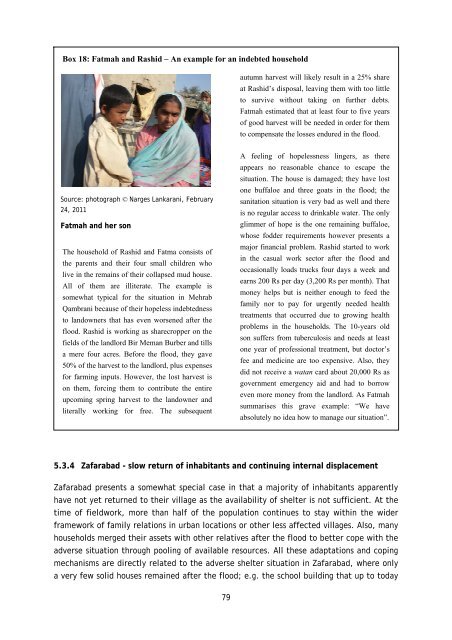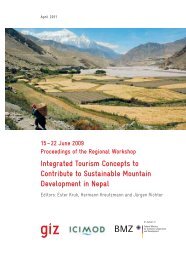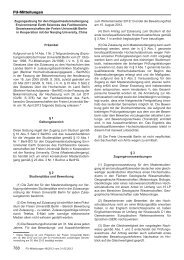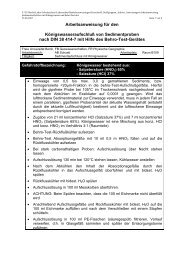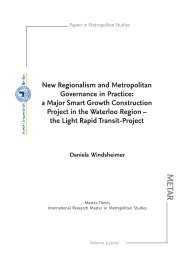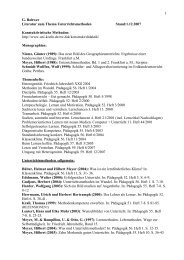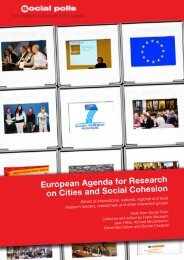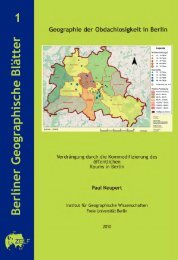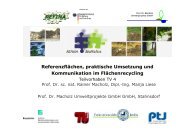After the Flood in Pakistan 38 Berlin Geographical Papers - Freie ...
After the Flood in Pakistan 38 Berlin Geographical Papers - Freie ...
After the Flood in Pakistan 38 Berlin Geographical Papers - Freie ...
You also want an ePaper? Increase the reach of your titles
YUMPU automatically turns print PDFs into web optimized ePapers that Google loves.
Box 18: Fatmah and Rashid – An example for an <strong>in</strong>debted household<br />
Source: photograph ©�Narges Lankarani, February<br />
24, 2011<br />
Fatmah and her son<br />
The household of Rashid and Fatma consists of<br />
<strong>the</strong> parents and <strong>the</strong>ir four small children who<br />
live <strong>in</strong> <strong>the</strong> rema<strong>in</strong>s of <strong>the</strong>ir collapsed mud house.<br />
All of <strong>the</strong>m are illiterate. The example is<br />
somewhat typical for <strong>the</strong> situation <strong>in</strong> Mehrab<br />
Qambrani because of <strong>the</strong>ir hopeless <strong>in</strong>debtedness<br />
to landowners that has even worsened after <strong>the</strong><br />
flood. Rashid is work<strong>in</strong>g as sharecropper on <strong>the</strong><br />
fields of <strong>the</strong> landlord Bir Meman Burber and tills<br />
a mere four acres. Before <strong>the</strong> flood, <strong>the</strong>y gave<br />
50% of <strong>the</strong> harvest to <strong>the</strong> landlord, plus expenses<br />
for farm<strong>in</strong>g <strong>in</strong>puts. However, <strong>the</strong> lost harvest is<br />
on <strong>the</strong>m, forc<strong>in</strong>g <strong>the</strong>m to contribute <strong>the</strong> entire<br />
upcom<strong>in</strong>g spr<strong>in</strong>g harvest to <strong>the</strong> landowner and<br />
literally work<strong>in</strong>g for free. The subsequent<br />
79<br />
autumn harvest will likely result <strong>in</strong> a 25% share<br />
at Rashid’s disposal, leav<strong>in</strong>g <strong>the</strong>m with too little<br />
to survive without tak<strong>in</strong>g on fur<strong>the</strong>r debts.<br />
Fatmah estimated that at least four to five years<br />
of good harvest will be needed <strong>in</strong> order for <strong>the</strong>m<br />
to compensate <strong>the</strong> losses endured <strong>in</strong> <strong>the</strong> flood.<br />
A feel<strong>in</strong>g of hopelessness l<strong>in</strong>gers, as <strong>the</strong>re<br />
appears no reasonable chance to escape <strong>the</strong><br />
situation. The house is damaged; <strong>the</strong>y have lost<br />
one buffaloe and three goats <strong>in</strong> <strong>the</strong> flood; <strong>the</strong><br />
sanitation situation is very bad as well and <strong>the</strong>re<br />
is no regular access to dr<strong>in</strong>kable water. The only<br />
glimmer of hope is <strong>the</strong> one rema<strong>in</strong><strong>in</strong>g buffaloe,<br />
whose fodder requirements however presents a<br />
major f<strong>in</strong>ancial problem. Rashid started to work<br />
<strong>in</strong> <strong>the</strong> casual work sector after <strong>the</strong> flood and<br />
occasionally loads trucks four days a week and<br />
earns 200 Rs per day (3,200 Rs per month). That<br />
money helps but is nei<strong>the</strong>r enough to feed <strong>the</strong><br />
family nor to pay for urgently needed health<br />
treatments that occurred due to grow<strong>in</strong>g health<br />
problems <strong>in</strong> <strong>the</strong> households. The 10-years old<br />
son suffers from tuberculosis and needs at least<br />
one year of professional treatment, but doctor’s<br />
fee and medic<strong>in</strong>e are too expensive. Also, <strong>the</strong>y<br />
did not receive a watan card about 20,000 Rs as<br />
government emergency aid and had to borrow<br />
even more money from <strong>the</strong> landlord. As Fatmah<br />
summarises this grave example: “We have<br />
absolutely no idea how to manage our situation”.<br />
5.3.4 Zafarabad - slow return of <strong>in</strong>habitants and cont<strong>in</strong>u<strong>in</strong>g <strong>in</strong>ternal displacement<br />
Zafarabad presents a somewhat special case <strong>in</strong> that a majority of <strong>in</strong>habitants apparently<br />
have not yet returned to <strong>the</strong>ir village as <strong>the</strong> availability of shelter is not sufficient. At <strong>the</strong><br />
time of fieldwork, more than half of <strong>the</strong> population cont<strong>in</strong>ues to stay with<strong>in</strong> <strong>the</strong> wider<br />
framework of family relations <strong>in</strong> urban locations or o<strong>the</strong>r less affected villages. Also, many<br />
households merged <strong>the</strong>ir assets with o<strong>the</strong>r relatives after <strong>the</strong> flood to better cope with <strong>the</strong><br />
adverse situation through pool<strong>in</strong>g of available resources. All <strong>the</strong>se adaptations and cop<strong>in</strong>g<br />
mechanisms are directly related to <strong>the</strong> adverse shelter situation <strong>in</strong> Zafarabad, where only<br />
a very few solid houses rema<strong>in</strong>ed after <strong>the</strong> flood; e.g. <strong>the</strong> school build<strong>in</strong>g that up to today


